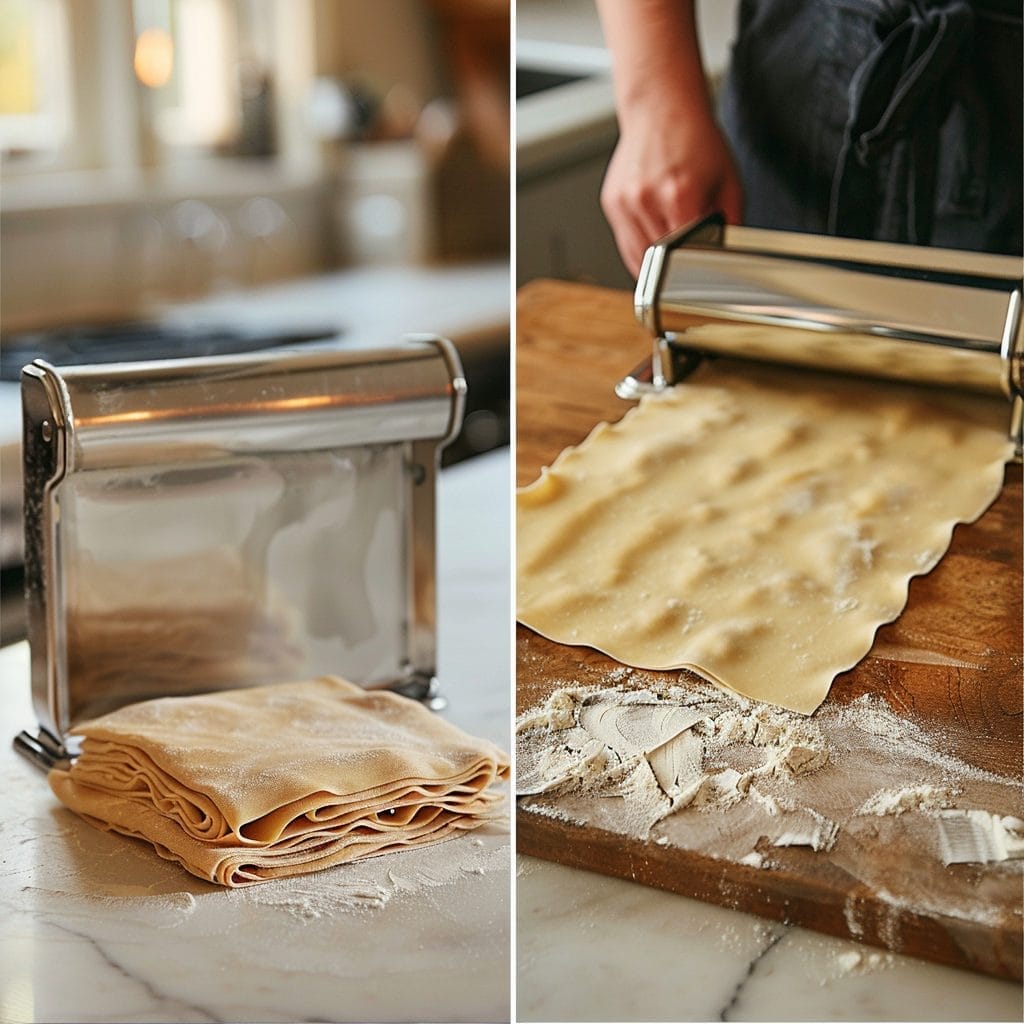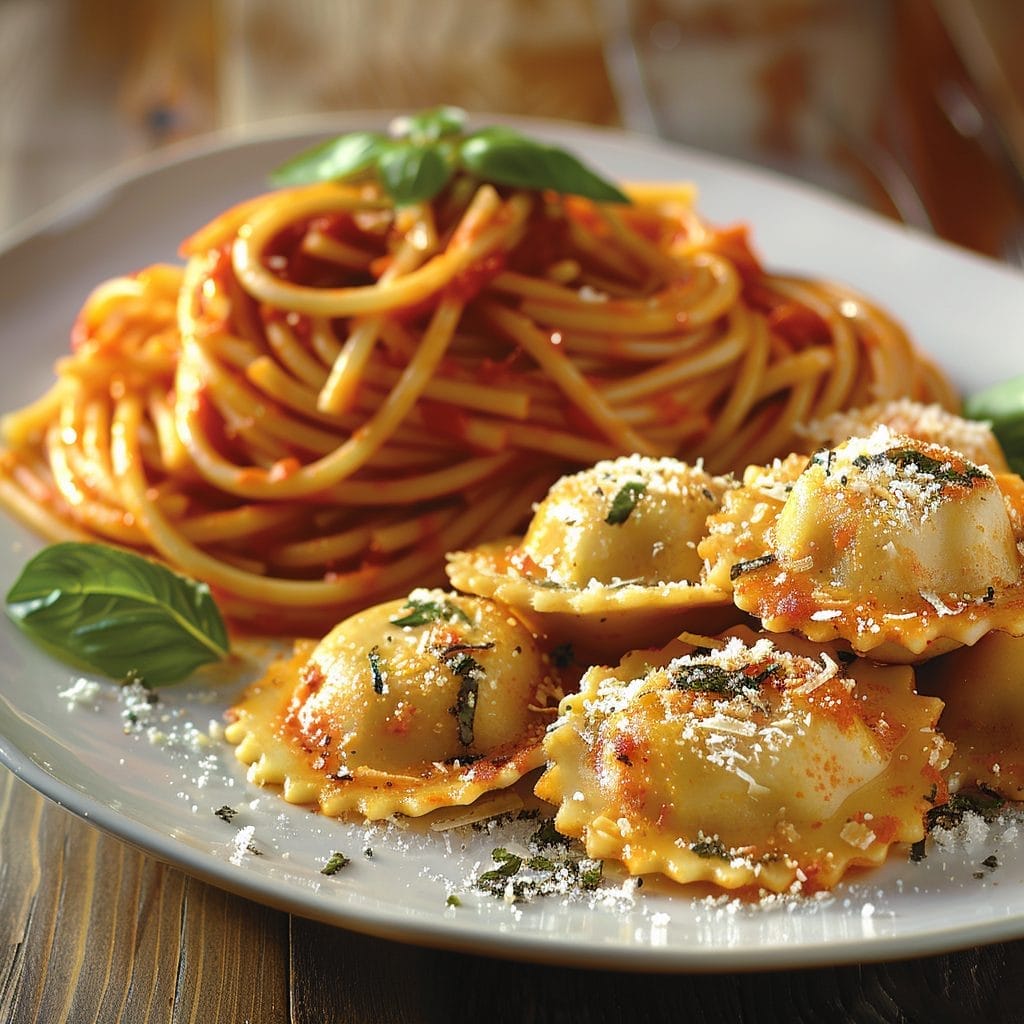Jump to Recipe
Imagine walking through the narrow, cobblestone streets of Rome, the aroma of fresh pasta sauce wafting through the air. You stumble upon a small family-owned trattoria where Nonna is rolling out dough, crafting each pasta shape by hand. I remember my first trip to Italy and how learning how to make pasta in Italy changed my entire outlook on cooking. The passion and tradition behind Italian cuisine are evident in every ingredient and every method.
Traditional Italian pasta-making isn’t just a culinary process; it’s an art form passed down through generations. The importance of handmade pasta lies not only in the flavors but also in the love and care poured into its creation.
By understanding these fundamental recipes and techniques, we can bring a taste of Italy into our own kitchens. So, let’s dive into the world of Italian cuisine and learn how to make pasta in italy that’s truly authentic.
The Magic of Fresh Ingredients
The secret to exceptional pasta lies in the fresh pasta ingredients you choose. With the right combination, the flavors and textures will transport you straight to Italy.
Choosing the Right Flour
Selecting high-quality pasta flour types is fundamental. I always recommend using Italian 00 flour. It’s finely ground, giving pasta a delicate texture. You can also explore semolina flour.
It adds a bit of bite and enhances the overall texture. Mixing these flours can yield a truly authentic pasta experience.
Using Fresh Eggs
Nothing compares to the richness of farm-fresh eggs. Their deep yellow yolks enrich the pasta, lending it a beautiful color and superior taste. Using these eggs over store-bought ones ensures your pasta is as fresh and flavorful as possible.
The higher quality impacts both texture and flavor, making each bite a delight.
Essential Pasta-Making Tools
Creating authentic Italian pasta at home requires more than just passion and ingredients; it demands the right pasta-making equipment to ensure success. Key among these tools are the pasta dough scraper and the manual pasta roller.
Dough Scraper
A pasta dough scraper is an indispensable kitchen utensil that assists in forming smooth, consistent pasta dough. It helps gather all the ingredients effortlessly and kneads the dough efficiently by minimizing sticky hands, making the entire process cleaner.
When selecting a pasta dough scraper, look for one made from durable stainless steel that has a comfortable handle. Proper use and maintenance involve cleaning it promptly after each use to prevent any dough residue build-up.
Pasta Roller
Another must-have tool in your pasta making equipment arsenal is a manual pasta roller. This tool is perfect for rolling out dough to the desired thickness, ensuring even and consistent pasta sheets ready for cutting.
Manual pasta rollers offer flexibility and control, which is ideal for home kitchens. When choosing one, consider brands like Marcato or KitchenAid, known for their reliability.
Regular maintenance involves lubricating the roller and cleaning it with a dry brush to prolong its life.
With the right kitchen utensils, making pasta can be a delightful and rewarding experience. These essential tools make the process smoother, helping you create delicious, homemade Italian pasta.

How to Make Pasta in Italy
The art of how to make pasta in italy is a revered tradition. Each step in the pasta-making process, from dough preparation to cutting different pasta shapes, showcases genuine Italian pasta techniques.
Mixing the Dough
First, I start with high-quality flour and fresh eggs. When mixing the dough, I make a well in the center of the flour mound, then crack the eggs into it. Using a fork, I gradually incorporate the flour until the dough forms.
Kneading is crucial. I work the dough for about 10 minutes to develop the gluten, ensuring it’s elastic and smooth. This is key to achieving that perfect texture in any Italian pasta technique.
Rolling Out the Dough
Rolling out the dough to the right thickness is essential. I use a pasta roller to achieve a consistent thinness. Starting with the widest setting, I pass the dough through, folding it in half with each pass. I gradually narrow the settings to get the desired thickness for the pasta shapes I’m making.
If you don’t have a pasta roller, a rolling pin works too. The goal is to get the dough thin enough so that you can almost see your hand through it when you hold it up to the light.
Cutting the Pasta
Once the dough is rolled out, it’s time to cutting the pasta. For fettuccine or pappardelle, I use a sharp knife to cut wide strips. For more uniform pasta, I might use a pasta cutter or machine.
Each shape has its own technique. For example, ravioli requires you to place filling between two sheets of dough, then cut and seal the edges. No matter the shape, the key is precision and care to ensure each piece cooks evenly.
Remember, practice makes perfect. With these traditional steps, you’re well on your way to mastering the pasta-making process and enjoying delicious homemade pasta, just like in Italy.
Cooking Your Fresh Pasta
Cooking fresh pasta is an art. To achieve that perfect al dente texture, you need to pay close attention. Start by filling a large pot with water and make sure it’s generously salted. This is key because salted water adds flavor to the pasta as it cooks.
Bring the water to a rolling boil before adding your fresh pasta. Once added, give it a gentle stir to prevent sticking. Fresh pasta cooks quickly, usually in about two to four minutes, depending on the thickness and type of pasta.
To ensure your pasta is cooked to perfection, taste-test it frequently. Al dente means “to the tooth” and should have a slight firmness when bitten but not be hard. Don’t rely solely on timing; checking the texture is crucial.
Here are a few pasta cooking tips:
- Use plenty of water to avoid overcrowding the pasta.
- Stir often to keep the pasta from clumping together.
- Drain promptly and toss with sauce immediately to prevent sticking.
Following these steps will make your pasta cooking experience delightful, bringing out the fresh, authentic flavors of your homemade creation.
Remember, the key is in the details—from boiling pasta correctly to achieving that desired al dente finish.

How to Make Pasta in Italy
Ingredients
Method
- Step-by-Step Guide:
- Mix the Dough:
- Place the flour in a mound on a clean surface. Make a well in the center and crack the eggs into it.
- Use a fork to gently mix the eggs into the flour, gradually incorporating the flour until a dough forms.
- Knead the Dough:
- Knead the dough for about 10 minutes until it is smooth and elastic. This helps develop the gluten, giving the pasta its perfect texture.
- Cover the dough with plastic wrap and let it rest for 30 minutes.
- Roll Out the Dough:
- Use a pasta roller to roll the dough to your desired thickness, starting with the widest setting and gradually narrowing it.
- If you don’t have a pasta roller, use a rolling pin to roll the dough as thin as possible.
- Cut the Pasta:
- Cut the rolled dough into your preferred pasta shape. For fettuccine or pappardelle, use a sharp knife. For other shapes, use a pasta cutter or machine.
- Cook the Pasta:
- Bring a large pot of salted water to a rolling boil. Add the fresh pasta and cook for 2 to 4 minutes, depending on the thickness.
- Taste frequently to ensure it’s cooked al dente—firm but not hard.
Notes
Stir occasionally to prevent sticking.
Fresh pasta cooks much quicker than dried pasta, so keep an eye on it!
Delicious Pasta Recipes to Try
If you’ve ever dreamed of how to make pasta in italy at home, look no further. Let’s dive into two timeless classics: homemade spaghetti and delicious ravioli. These recipes will bring the flavors of Italy right into your kitchen.
Homemade Spaghetti
Creating your own spaghetti is simpler than you might think. Begin with a basic dough made from flour and eggs. Knead until smooth, then let it rest before rolling it out and cutting into long, elegant strands.
For the ultimate spaghetti recipe, consider pairing it with a robust tomato sauce. Start by sautéing garlic and onions, then add crushed tomatoes, basil, and a pinch of salt.
Allow the sauce to simmer, letting the flavors meld beautifully. Toss your freshly cooked spaghetti in the sauce, and finish with a sprinkle of Parmesan cheese.
Ravioli
Homemade ravioli offers endless possibilities when it comes to fillings. Start with the same dough preparation as the spaghetti, but instead of cutting into strands, you’ll roll it out into thin sheets.
One delectable filling option is a combination of ricotta, spinach, and Parmesan. Spoon small amounts of the filling onto one sheet of dough, then cover with another sheet and press to seal.
Cut into individual ravioli pieces. Boil until they float to the top, and serve with a sage butter sauce or a simple tomato sauce.
Both the spaghetti recipe and homemade ravioli capture the essence of traditional Italian pasta recipes.
Don’t be afraid to experiment with different sauces and fillings; these pasta dishes are incredibly versatile and can be tailored to suit any taste preference.

Conclusion
Embarking on the journey of mastering how to make pasta in itlay at home isn’t just about creating delicious meals; it’s about embracing a tradition rooted in history and culture.
Fresh ingredients, right tools, and authentic techniques are the keys to unlocking pasta perfection. Through patience and practice, you’ll find joy in every step of the process.
How to make pasta in Italy at home offers something magical as you mix, roll, and cut the dough, transforming simple ingredients into culinary masterpieces.
From prepping the table with flour to savoring a delightful bite of homemade spaghetti or ravioli, each moment is rewarding. Remember, every attempt brings you closer to perfection.
As you continue your culinary journey, don’t hesitate to explore the vast world of Italian cooking. With perseverance and passion, you can elevate your kitchen endeavors.
Let this be the beginning of many flavorful adventures where you strive for pasta perfection, savoring the love and artistry that each dish brings.
FAQ
What is the secret to making traditional Italian pasta?
The secret is in the technique and quality of ingredients. Use traditional Italian 00 flour, fresh farm eggs, and devote time to mastering the perfect dough consistency.
Why is Italian 00 flour recommended for pasta making?
Italian 00 flour is finely ground and offers the best texture for pasta. It helps achieve that silky, smooth consistency which makes pasta truly exceptional.
How do I choose the right type of eggs for making pasta?
Fresh, farm-fresh eggs give the best results! The richer yolks add more color and flavor to the pasta, contrasting with standard store-bought eggs.
What tools do I need to start making pasta at home?
Essential tools include a dough scraper and a pasta roller. These help in maintaining the right dough texture and thickness, whether you opt for manual or electric equipment.
What are the steps to mix pasta dough the traditional Italian way?
Begin by creating a well with the flour, crack the eggs into the center, and gently mix them together. The key is to knead the dough until it’s smooth and elastic.
How do I know when the pasta dough is rolled out to the right thickness?
For different pasta shapes, you’ll need various thicknesses. Generally, you should be able to see your hand through the dough when held up to the light for most types.
What’s the best way to cut the pasta?
You can use knives for wider shapes like pappardelle or pasta cutters for uniformity. Experiment with different methods to find your preferred style.
How should I cook fresh pasta to achieve the perfect ‘al dente’?
Boil the pasta in salted water and taste it during cooking. Fresh pasta cooks faster than dried, so pay attention to avoid overcooking.
What tips do you have for preventing fresh pasta from sticking together?
Ensure the water is rapidly boiling, stir often, and use plenty of salt. Also, a little olive oil in the water can help prevent sticking.
Can you share a simple homemade spaghetti recipe?
Sure! Combine Italian 00 flour, farm-fresh eggs, and salt to make the dough. Roll it out, cut into strips, and pair with a classic tomato basil sauce for an authentic taste.
How do I make homemade ravioli?
Start with the same dough and fill it with ricotta, spinach, or your favorite fillings. Seal the edges, boil until tender, and enjoy with a sage butter sauce or marinara.
